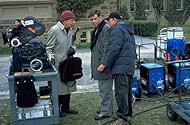John Nash(1928-2015)
John Nash was an American mathematician who made fundamental contributions to game theory, differential geometry, and the study of partial differential equations. Nash's work has provided insight into the factors that govern chance and decision-making inside complex systems found in everyday life.
His theories are widely used in economics. Serving as a Senior Research Mathematician at Princeton University during the latter part of his life, he shared the 1994 Nobel Memorial Prize in Economic Sciences with game theorists Reinhard Selten and John Harsanyi. In 2015, he also shared the Abel Prize with Louis Nirenberg for his work on nonlinear partial differential equations.
Nash's mental illness first began to manifest in the form of paranoia; his wife later describing his behavior as erratic. Nash seemed to believe that all men who wore red ties were part of a communist conspiracy against him; Nash mailed letters to embassies in Washington, D.C., declaring that they were establishing a government. Nash's psychological issues crossed into his professional life when he gave an American Mathematical Society lecture at Columbia University in 1959. Originally intended to present proof of the Riemann hypothesis, the lecture was incomprehensible. Colleagues in the audience immediately realized that something was wrong.
He was admitted to McLean Hospital in April 1959, staying through May of the same year. There, he was diagnosed with paranoid schizophrenia. According to the Diagnostic and Statistical Manual of Mental Disorders, or DSM, a person suffering from the disorder is typically dominated by relatively stable, often paranoid, fixed beliefs that are either false, over-imaginative or unrealistic, and usually accompanied by experiences of seemingly real perception of something not actually present. Further signs are marked particularly by auditory and perceptional disturbances, a lack of motivation for life, and mild clinical depression.
In 1961, Nash was admitted to the New Jersey State Hospital at Trenton. Over the next nine years, he spent periods in psychiatric hospitals, where he received both antipsychotic medications and insulin shock therapy.
His struggles with his illness and his recovery became the basis for Sylvia Nasar's biography, A Beautiful Mind, as well as a film of the same name starring Russell Crowe.
On May 23, 2015, Nash and his wife, Alicia Nash, were killed in a car crash while riding in a taxi on the New Jersey Turnpike.
His theories are widely used in economics. Serving as a Senior Research Mathematician at Princeton University during the latter part of his life, he shared the 1994 Nobel Memorial Prize in Economic Sciences with game theorists Reinhard Selten and John Harsanyi. In 2015, he also shared the Abel Prize with Louis Nirenberg for his work on nonlinear partial differential equations.
Nash's mental illness first began to manifest in the form of paranoia; his wife later describing his behavior as erratic. Nash seemed to believe that all men who wore red ties were part of a communist conspiracy against him; Nash mailed letters to embassies in Washington, D.C., declaring that they were establishing a government. Nash's psychological issues crossed into his professional life when he gave an American Mathematical Society lecture at Columbia University in 1959. Originally intended to present proof of the Riemann hypothesis, the lecture was incomprehensible. Colleagues in the audience immediately realized that something was wrong.
He was admitted to McLean Hospital in April 1959, staying through May of the same year. There, he was diagnosed with paranoid schizophrenia. According to the Diagnostic and Statistical Manual of Mental Disorders, or DSM, a person suffering from the disorder is typically dominated by relatively stable, often paranoid, fixed beliefs that are either false, over-imaginative or unrealistic, and usually accompanied by experiences of seemingly real perception of something not actually present. Further signs are marked particularly by auditory and perceptional disturbances, a lack of motivation for life, and mild clinical depression.
In 1961, Nash was admitted to the New Jersey State Hospital at Trenton. Over the next nine years, he spent periods in psychiatric hospitals, where he received both antipsychotic medications and insulin shock therapy.
His struggles with his illness and his recovery became the basis for Sylvia Nasar's biography, A Beautiful Mind, as well as a film of the same name starring Russell Crowe.
On May 23, 2015, Nash and his wife, Alicia Nash, were killed in a car crash while riding in a taxi on the New Jersey Turnpike.





